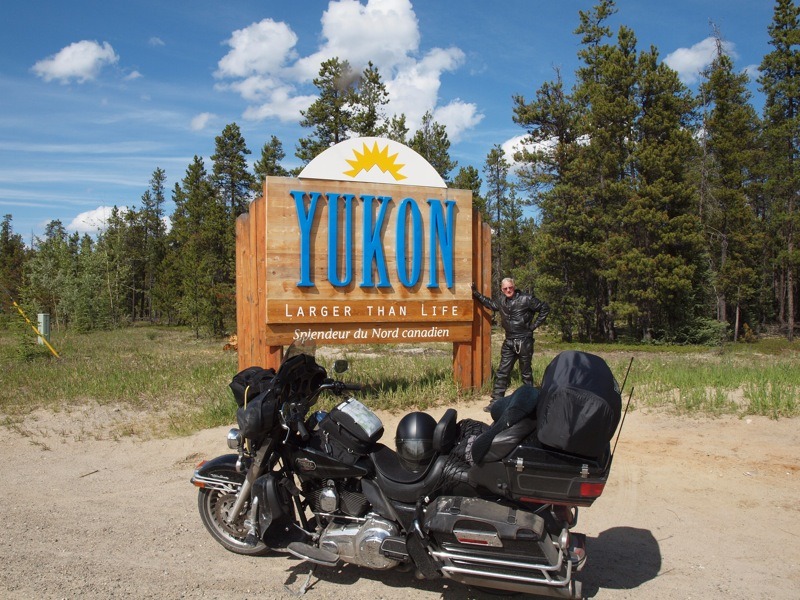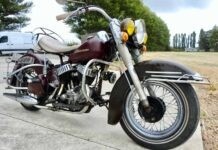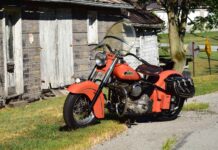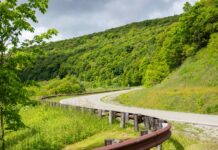You have finally decided you are going on the ride of a lifetime. If that ride will take you to Alaska you need to start planning at least a year in advance. A ride to the land known as “The Last Frontier” is a ride like no other, and one that requires a lot of planning and preparation.

I started to plan my last ride to Alaska a year prior to my departure date. The first thing I did was purchase a copy of The Milepost, the bible of North Country travel. If you go to Alaska this is the one publication you will need to take with you since it documents all the routes to Alaska, mile by mile. I also contacted Alaska Tourism along with British Columbia, Alberta and Yukon Tourism. Next I mapped out my route. There are two routes to Alaska with the Alaska Highway the most traveled and the Cassiar Highway more remote. After mapping out my route I totaled up the mileage. This trip would take just over 11,000 miles round trip from my home in Ohio. Since I wanted to see as much of Alaska and Western Canada as possible and not be on a strict schedule, I decided I would need 31 days to make this ride happen, averaging 300 miles a day. This would allow me plenty of time to enjoy the North Country even if I encountered poor road conditions and bad weather, plus I would be able to take a number of side trips along the way. The ride really starts when you enter Canada; so give yourself plenty of time so you can take all this country in.

Once I have mapped out my route and allotted the time I will need, I always go on the Internet and make up a list of motels in every town I will pass through so I can call ahead each day and make a reservation for the next night. If you do not do this you may find yourself without a room with the next lodging 300 miles up the road. Rooms are limited in the North Country, and this applies to campgrounds, as well. Next, be sure you have a current passport or passport card. One of these is now required to cross the border when you enter Canada and then return to the Lower 48. If you have had a previous DUI/DWI you may be refused entry into Canada. (DUI/DWI is considered a felony in Canada.) However, you may apply for an admittance permit, which can take up to a year and cost up to $1,500. If you try to cross the border without a permit and are not refused entry, please remember you have to cross back into Canada to return and could be refused entry at this point. If this happens you have only two options: ship the bike home and buy an airline ticket or book passage on a ship to Seattle. Both are very expensive options.
Of course you will need to prepare your bike for the ride. I had my bike serviced the week before I left. Since I would be riding over 11,000 miles new tires are a must, unless you plan on having tires installed at a dealer along the way. Plan accordingly and remember that the nearest dealer may be 500 miles away in the North Country. I planned to get my 5,000-mile service done in Fairbanks, but you need to be prepared to make minor roadside repairs, as well. Some of the things I feel are essential are a tool kit, two cans of Seal ‘N’ Air tire sealant, a tire plugger kit, a mini tire compressor, a large roll of duct tape, heavy-duty wire ties, extra bungee cords in different lengths and two tie-down straps in case you need to have your bike hauled to the nearest town for repair. Don’t forget to carry some octane boost since many of the gas stations only have 87 octane available. I also always rent a satellite phone when I travel in remote areas. Your cell phone will work in only a few of the towns along the way. Cell coverage is very limited and can be nonexistent if you do not purchase Canadian coverage prior to your trip.

My friends who do not ride always ask how I am able to pack all I need for a long trip on a motorcycle. My answer is always the same: I only pack what I need, not what I want. I pack for a week no matter how long I plan to be on the road. I do laundry once a week along the way. However, there are things that are a must. Top-quality leathers are at the top of my list along with good-quality rain gear that can be worn over your leathers. Native Alaskans will tell you it only rains twice a week in the North Country—once for three days and once for four days. It’s not really that bad, but be prepared to ride in the rain and maybe even some snow. You must make yourself waterproof.
I prefer leather overpants rather than chaps since they are warmer. You will also need a warm pair of waterproof gloves, and a heated jacket liner is an option you may want to consider and one that I highly recommend. Also note that DOT-approved helmets are required in Canada. I would recommend either a full-face or three-quarter helmet with a face shield for two reasons: When you see a sign that says “Pavement break ahead—Slow down,” that break could be 10 feet or 10 miles. The face shield will protect you from stones being thrown up by other traffic. The other reason why I recommend a helmet with a face shield is to protect your face from rain and wind.

Some of the hazards you face may not be what you’d think about riding in the North Country. You will most likely see bears along your route, but as long as you keep your distance they will not be a problem. I know of one rider who decided to take a shotgun for bear protection. First of all, the only thing a shotgun will do is piss that bear off. Leave your shootin’ irons at home. Handguns are illegal in Canada, as are bear spray, pepper spray and mace. In my experience the number one hazard is Ma and Pa in that motorhome that’s the size of a Greyhound bus taking their half, and yours, out of the middle of the highway. Another hazard is moose on the highway, most likely to be encountered late in the day, and a good example of why I like to be in my motel by around 5:00 p.m. If you hit a moose, both you and the moose will lose.
The roads in the North are not all gravel like they were many years ago. In fact, I would say with some exceptions the two-lane highways are as good as any in the Lower 48. Construction is always going on during the summer months, and you’ll know you’ve entered a construction zone when the pavement is completely ripped up and turns into hard-pack gravel. The construction crews apply calcium chloride to the surface, which makes the surface as hard as concrete. There are several drawbacks to this for the rider. For one, when it’s wet, it’s as slippery as snot. Pilot trucks will lead you through the construction zones, so when you see traffic stopped for construction carefully pull to the head of the line behind the pilot truck. Motorcycles are expected to be first in line. If you are riding two-up you may want to ask the pilot car driver if your passenger can ride in the pilot truck to lessen the weight and give you better control of the bike. (I have never been turned down with this request.) If you travel through a construction zone you must high-pressure wash your bike that evening to get the calcium chloride off or it will turn to stone. Most of the motels and campgrounds have wash facilities. Last but not least, you will encounter frost heaves on occasion, so just slow down and maneuver accordingly. The worst stretch of frost heaves I encountered on my last trip was from Burwash Landing in the Yukon to the Alaska border.

If you start planning now, you will have a ride of a lifetime. All that planning will pay off and you will have a great ride with plenty of stories to tell your buddies when you get home. Alaska is in reach for the rider who prepares in advance. Now enjoy the ride!
Sources
The Milepost
www.themilepost.com
800.726.4707
Alaska Tourism
www.travelalaska.com
480.483.1551
Yukon Territory
www.travelyukon.com
800.661.0494
British Columbia Tourism
www.hellobc.com
800.435.5622
Alberta Tourism
www.travelalberta.com
800.661.8888



















Larry — this is great little article. Thanks for the tips. I am beginning to plan our trip to Alaska this summer. I am not new to planning trips we usually do “a trip of a lifetime” every year. We take a 3 week trip across country every year and in the past 5 years we have been able to cover the entire lower 48 and all the way across Canada (only 3 Canadian provinces we have not been in yet). And have encountered everything from extreme heat in Nevada (122 degrees), to 30 mph winds, and 9 days of rain in a row on the East coast to break downs and some really cold weather in New Brunswick and Banff. I have to say, I am more than a little apprehensive about planning this trip to Alaska.
So thanks for the info and the little confidence boost that this is doable.
Larry – good advice about Alaska (I’m a 42 year Alaskan sourdough. One suggestion – you’ve mislabeled the glacier in two of your photos. That’s the mighty Matanuska glacier, not the Worthington. The Worthington glacier can be seen from the Richardson hwy, not the Glenn hwy and is near Valdez in the Thompson Pass.
Larry -this is a great article with awesome tips I will use for preparation of our next trip. One note for travellers:
Bear spray is legal in Canada and highly recommended for those travelling the back country.
See: Parks Canada website
http://www.pc.gc.ca/eng/pn-np/mtn/ours-bears/securite-safety/gaz-spray.aspx
Nice article. Thanks. I did Minnesota to Alaska on motorcycle in 1989. Planning to again this summer (2018).
You mentioned ‘Motorcycles are expected to be first in line’ in stopped traffic areas for construction. The 1st time I heard that was from a flagger on a highway in South Dakota. I am hoping to pre-myself to respond to any disgruntled others in such a situation. Do you have any ‘official’ looking references to help me on on this one?
Larry, this is pure gold. I started planning our ride for 2021 today. Your article is very direct and gives an excellent perspective of what it is going to take. Thank you. Now, to begin planning…
I too am planning a trip to Alaska but one concern is will the borders be open due to the pandemic
Planning to go in July so far a solo ride . I am 66 and kicking looking for other(s) to ride with part or the whole way .
Vegas Fairbank Sturgis Vegas !!